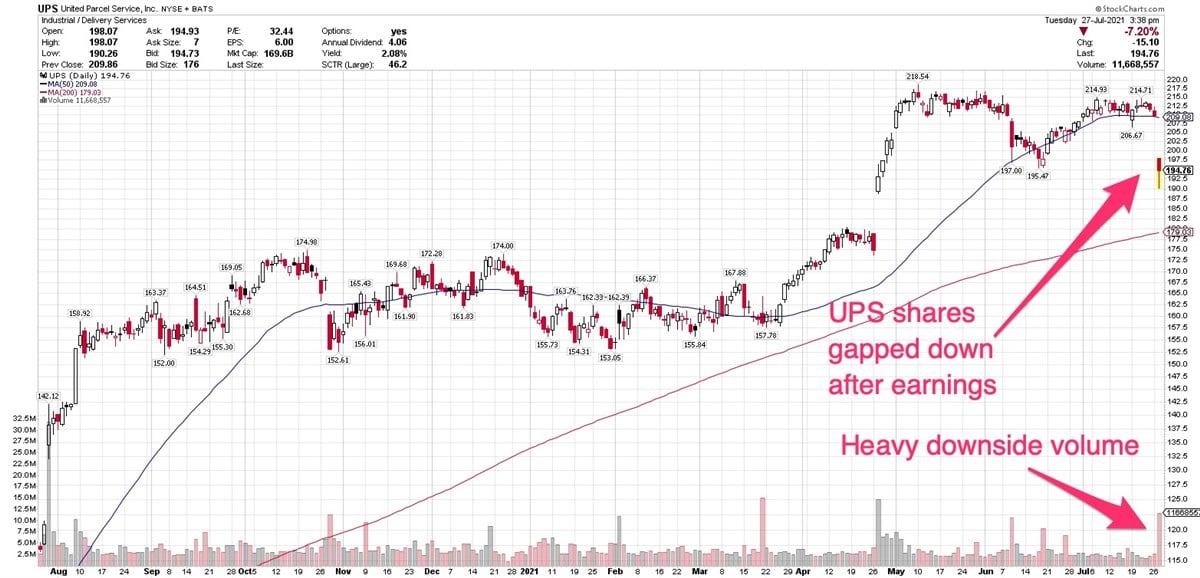Shares of
United Parcel Service NYSE: UPS gapped down Tuesday morning after the company reported second-quarter results that beat on both the top-and-bottom lines.
The move lower followed an uptick in pre-market trade, but as investors dug into the report, they found some things not to their liking. In particular, revenue for the U.S. business segment failed to meet forecasts.
The delivery giant reported an income of $3.06 per share, up 44% from a year ago, and up from $2.77 per share in the prior quarter. Second-quarter results topped the consensus estimate of $2.81 per share.
Revenue came in at $23.42 billion, up 14% year-over-year. That was also ahead of views, which called for revenue of $20.46 billion.
However, U.S. domestic revenue came up short, despite growing to $14.40 billion, a gain of 10.2%. Analysts expected domestic revenue of $14.76%.
Internationally, revenue was up by 30%, to $4.82 billion, ahead of forecasts calling for $4.57 billion. UPS’ supply-chain solution business segment contributed $4.21 billion, a year-over-year increase of 14.3%, also topping views.
The disappointing U.S. revenue may reflect some pessimism on Wall Street about how the domestic economic rebound will affect UPS. There are concerns that pandemic-driven online ordering may be slowing, although it’s possible that consumer habits have permanently shifted away from so much in-person shopping.
In addition, depending on the length and severity of the Covid-19 delta variant, shoppers may continue buying online rather than venturing out as much as planned.
This quarter marked a slowdown in earnings and revenue growth, after five quarters in a row of revenue acceleration, and three quarters of earnings acceleration.
For the full year, UPS guided toward a consolidated operating margin of around 12.7% and approximately 28% return on invested capital. The company also reaffirmed its full-year capital allocation plans.
- The company expects capital expenditures to be about $4.0 billion
- Long-term debt repayments of $2.55 billion have been completed
- The effective tax rate for the rest of the year is expected to be around 23%
Also in the quarter, the company completed the sale of its UPS Freight, its “less than a truckload” shipping division to TFI.
According to UPS’ earnings release, “The sale triggered re-measurement of certain U.S. pension and postretirement benefit plans. As a result, UPS pension and postretirement liabilities were lowered by $2.1 billion. The re-measurement had no meaningful impact to the company’s consolidated second-quarter net earnings.”
In addition, year-to-date cash from operations clocked in at $8.5 billion, a gain of 42.2% over the year-ago quarter. UPS said its free cash flow was $6.8 billion, a 74.7% gain above the first six months of 2020.
For the full year, analysts expect UPS to deliver earnings per share of $11.04, up 34%. Wall Street is eyeing earnings growth of 5% in 2022, another signal that growth may be slowing.
As global supply chain bottlenecks put the squeeze on various industries, UPS and rival FedEx NYSE: FDX upped surcharges. According to the announcement on UPS’ Web site, as of June 25, “a peak surcharge will apply to shipments originating from China Mainland and Hong Kong SAR to the U.S.”
The stock had been forming a flat base, but Tuesday’s gap-down changed the character of the consolidation. It undercut the base’s prior low of $195.47.
The downside action made UPS the second-biggest S&P 500 decliner mid-session Tuesday, behind food processor Lamb Weston NYSE: LW.
In Tuesday’s session, the stock was finding support 8.7% above its 200-day moving average, potentially a sign that selling may remain muted.
In the S&P Industrials sector, UPS was the biggest laggard Tuesday. UPS is the second-heaviest weighting within the sector, meaning its decline will make a dent in sector performance.
July now marks the second month of decline for UPS shares, after retreating from their May 10 high of $219.59.

Before you consider United Parcel Service, you'll want to hear this.
MarketBeat keeps track of Wall Street's top-rated and best performing research analysts and the stocks they recommend to their clients on a daily basis. MarketBeat has identified the five stocks that top analysts are quietly whispering to their clients to buy now before the broader market catches on... and United Parcel Service wasn't on the list.
While United Parcel Service currently has a Hold rating among analysts, top-rated analysts believe these five stocks are better buys.
View The Five Stocks Here
Unlock your free copy of MarketBeat's comprehensive guide to pot stock investing and discover which cannabis companies are poised for growth. Plus, you'll get exclusive access to our daily newsletter with expert stock recommendations from Wall Street's top analysts.
Get This Free Report